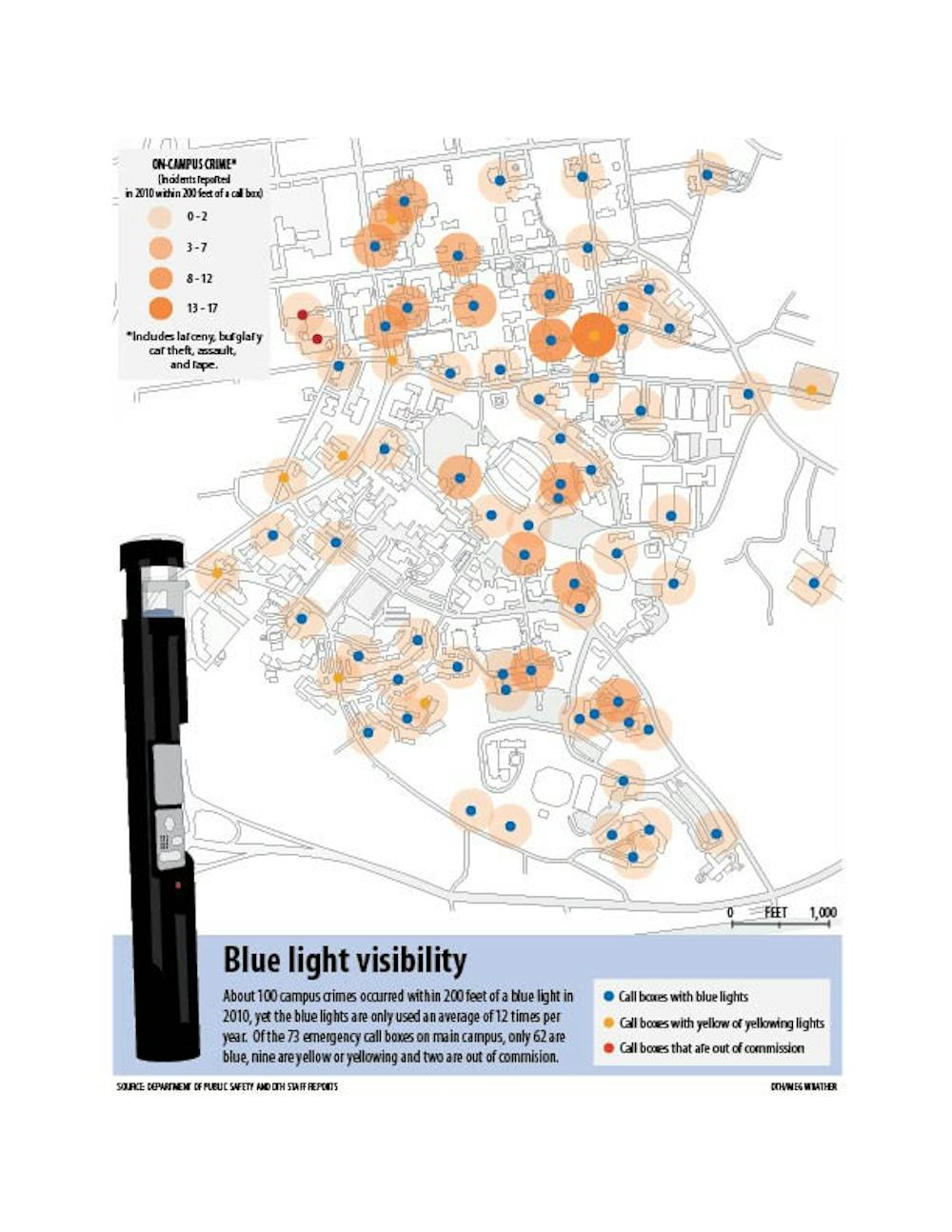According to a campus map updated in September, 73 call boxes are located on main campus.
Eight have a yellowed or yellowing main light — two of those are completely yellow and one is yellowing and hidden by a tree.
Two lights have buttons that visibly don’t work, though one appeared functional except for a sticker placed over the button stating that the box needs programming.
Young said yellowing could impact a lights’ usefulness.
“My understanding is that it just would not be as recognizable with the other lights on campus.”
Raymond DuBose is director of energy services at the University, which services the roughly 200 call boxes on UNC property, including those in parking decks, University parking lots and at the Friday Center. He said since Carson’s death, extra attention has been paid to the boxes.
“We went back and reviewed our maintenance procedure and gave more focused attention following that,” he said. “It raised everyone’s level of awareness somewhat, and level of concern.”
He said yellowing has been a persistent problem, but that is to be expected since lights fade with age and there are too many blue lights to check regularly.
“That happens over time, and they yellow with age and we replace the globe,” he said. “If anybody sees a light that is yellowing or burned out, call electric services.”
Blue box usefulness
Young said campus police receive about one emergency call each month from the boxes.
Gunter said the off-campus boxes are also rarely used.
“We’ve had just a few calls, if not less,” he said.
Young said though call boxes are used rarely and require maintenance, the University will keep them because the lights signal a police presence.
“Most folks now utilize cellphones,” he said. “One of the major functions that these have currently is that they are a deterrent to crime.”
Neither Young nor DuBose could say how much the lights cost to maintain because blue light maintenance is just part of a larger budget.
To get the day's news and headlines in your inbox each morning, sign up for our email newsletters.
But twice as many similar lights at N.C. State University cost about $100,000 a year to maintain, said Scott McInturf, director of security applications and technology at N.C. State.
McInturf said the school’s 400 boxes were rarely used, and high maintenance costs prompted his office to look for ways to make the lights more useful and efficient.
N.C. State is now testing call box renovations that could link boxes to the university’s Internet network through a fiber connection, equip them with video capabilities and cost up to $8 million if expanded to the entire campus.
The school is in the process of re-outfitting three lights with fiber connections in a test program slated for spring 2012 completion.
McInturf came up with the idea for the fiber connection, which he said could eventually be used to broadcast campus messages.
“The fiber gives us the option to do things that we could not do today,” he said. “The premise is that blue light technology is dated.”
McInturf said the fiber connections — which could cost $10,000 to $20,000 to add per call box — could be expanded to all campus boxes if they prove useful. He hopes to get installation costs down to $10,000.
Each box originally cost $10,000 to $15,000 to install.
“When you look at what it costs annually to maintain these things, at some time it might lower costs. We might get more per dollar,” McInturf said.
The pilot blue lights are located in the school’s Centennial Campus park and ride lot, a spot McInturf said is known for high crime.
“It seemed appropriate,” he said.
McInturf said to his knowledge, N.C. State is the only school revamping outdated call boxes, and others are eliminating theirs.
The town of Boulder, Colo. removed several call boxes near the University of Colorado in spring 2011.
“We went back and took a look at the statistics, and over a period of years — it might have been two or three years — there was not one legitimate phone call that we got from those,” said Greg Testa, deputy police chief of the Boulder Police Department.
Testa said the call boxes removed were in town, and boxes on the University of Colorado campus have been retained.
He said the university was involved in the city government’s decision to take them away.
“When they were first put in and technology was different, we would get calls. And then, as cellphones developed, they became outdated.”
He said he does not believe the call boxes signaled a police presence or served as a crime deterrent — prank callers used them, which he said showed a lack of respect for authority.
Young wrote in an email that while neither Boulder nor N.C. State are alone — universities nationwide are re-examining call boxes’ worth — that doesn’t change things at UNC.
“Understand that this is being investigated or undertaken by several universities, but it’s not something we’re looking into at this time, in part due to high cost.”
Contact the City Editor
at city@dailytarheel.com.



